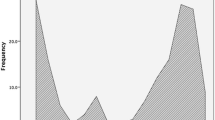Abstract
There is often a diagnostic dilemma in pediatric patients presenting with depressed ventricular function, as myocarditis and dilated cardiomyopathy (DCM) of other etiologies can appear very similar. Accurate identification is critical to guide treatment and to provide families with the most accurate expectation of long-term outcomes. The objective of this study was to identify patterns of clinical presentation and to assess non-invasive measures to differentiate patients with acute myocarditis from other forms of DCM. We identified all children (< 18 years) from our institution with a diagnosis of idiopathic DCM or myocarditis based on endomyocardial biopsy or explant pathology (1996–2015). Characteristics at the time of presentation were compared between patients with a definite diagnosis of myocarditis and those with idiopathic DCM. Data collected included clinical and laboratory data, radiography, echocardiography, and cardiac catheterization data. A total of 58 patients were included in the study; 46 (79%) with idiopathic DCM and 12 (21%) with acute myocarditis. Findings favoring a diagnosis of myocarditis included a history of fever (58 vs. 15%, p = 0.002), arrhythmia (17 vs. 0%, p = 0.003), higher degree of cardiac enzyme elevation, absence of left ventricular dilation (42 vs. 7%, p = 0.002), segmental wall motion abnormalities (58 vs. 13%, p = 0.001), lower left ventricular dimension z-score (3.7 vs. 5.2, p = 0.031), and less severe depression of left ventricular systolic function. There are notable differences between patients with myocarditis and other forms of DCM that can be detected non-invasively at the time of presentation without the need for endomyocardial biopsy. These data suggest that it may be possible to develop a predictive model to differentiate myocarditis from other forms of DCM using non-invasive measures.
Similar content being viewed by others
References
Towbin JA et al (2006) Incidence, causes, and outcomes of dilated cardiomyopathy in children. JAMA 296(15):1867–1876
Everitt MD et al (2014) Recovery of echocardiographic function in children with idiopathic dilated cardiomyopathy: results from the pediatric cardiomyopathy registry. J Am Coll Cardiol 63(14):1405–1413
Wilkinson JD et al (2010) The Pediatric Cardiomyopathy Registry and heart failure: key results from the first 15 years. Heart Fail Clin 6(4):401–413
Lipshultz SE et al (2003) The incidence of pediatric cardiomyopathy in two regions of the United States. N Engl J Med 348(17):1647–1655
Nugent AW et al (2001) Clinical, electrocardiographic, and histologic correlations in children with dilated cardiomyopathy. J Heart Lung Transpl 20(11):1152–1157
Lee KJ et al (1999) Clinical outcomes of acute myocarditis in childhood. Heart 82(2):226–233
English RF et al (2004) Outcomes for children with acute myocarditis. Cardiol Young 14(5):488–493
Canter CE, Simpson KE (2014) Diagnosis and treatment of myocarditis in children in the current era. Circulation 129(1):115–128
Richardson P et al (1996) Report of the 1995 World Health Organization/International Society and Federation of Cardiology Task Force on the definition and classification of cardiomyopathies. Circulation 93(5):841–842
Cowley CG et al (2003) Safety of endomyocardial biopsy in children. Cardiol Young 13(5):404–407
Pophal SG et al (1999) Complications of endomyocardial biopsy in children. J Am Coll Cardiol 34(7):2105–2110
Zhorne D et al (2013) A 25-year experience of endomyocardial biopsy safety in infants. Catheter Cardiovasc Interv 82(5):797–801
Vitiello R et al (1998) Complications associated with pediatric cardiac catheterization. J Am Coll Cardiol 32(5):1433–1440
Soongswang J et al (2005) Cardiac troponin T: a marker in the diagnosis of acute myocarditis in children. Pediatr Cardiol 26(1):45–49
Soongswang J et al (2002) Cardiac troponin T: its role in the diagnosis of clinically suspected acute myocarditis and chronic dilated cardiomyopathy in children. Pediatr Cardiol 23(5):531–535
Kleinert S et al (1997) Myocarditis in children with dilated cardiomyopathy: incidence and outcome after dual therapy immunosuppression. J Heart Lung Transplant 16(12):1248–1254
Aretz HT et al (1987) Myocarditis. A histopathologic definition and classification. Am J Cardiovasc Pathol 1(1):3–14
Cihakova D, Rose NR (2008) Chapter 4 pathogenesis of myocarditis and dilated cardiomyopathy. Adv Immunol 99:95–114
Durani Y et al (2009) Pediatric myocarditis: presenting clinical characteristics. Am J Emerg Med 27(8):942–947
Angelini A et al (2000) Myocarditis mimicking acute myocardial infarction: role of endomyocardial biopsy in the differential diagnosis. Heart 84(3):245–250
Funding
This study was not a funded study as it was a retrospective review of charts which had clinical data collected as part of routine standard of care for these patients.
Author information
Authors and Affiliations
Corresponding author
Ethics declarations
Conflict of interest
None of the authors has a financial relationship with a commercial entity that has an interest in the subject of the presented manuscript or other conflicts of interest to disclose.
Ethical Approval
All procedures performed in studies involving human participants were in accordance with the ethical standards of the institutional and/or national research committee and with the 1964 Helsinki declaration and its later amendments or comparable ethical standards. This retrospective study was approved by the Vanderbilt University Institutional Review Board.
Informed Consent
Informed consent was not obtained from all individual participants included in the study as waiver of request for consent was obtained from the Vanderbilt University Institutional Review Board as this was a retrospective review study.
Rights and permissions
About this article
Cite this article
Suthar, D., Dodd, D.A. & Godown, J. Identifying Non-invasive Tools to Distinguish Acute Myocarditis from Dilated Cardiomyopathy in Children. Pediatr Cardiol 39, 1134–1138 (2018). https://doi.org/10.1007/s00246-018-1867-y
Received:
Accepted:
Published:
Issue Date:
DOI: https://doi.org/10.1007/s00246-018-1867-y




